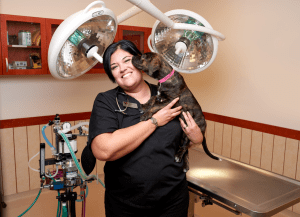Interview with Dr. Jena Valdez, San Francisco SPCA Chief Medical Officer

How long have you worked at the SF SPCA?
8.5 years.
Do you have pets?
Yes! Oscar, an 11-year-old dachshund and Simon, a 9-year-old shorthaired tabby.
How would you describe the SF SPCA in one word?
Innovative.
What motivates your work at the SF SPCA?
At the SF SPCA, we’re always searching for better ways to provide care, drive conversations, and push limits that others may not. Right now, we’re looking at veterinary care in a new way, thinking about how we can deliver lifesaving services for pets and the people who love them. We’re being deliberate about how we bring clients in and how we can cast the biggest net to reach as many people as possible.
How did the monthly Mobile Vaccine Clinic (MVC) at the Cow Palace and low-cost Call-Ahead Clinic (CAC) at the Mission Campus begin?
In 2010, I was working in the SF SPCA hospital, and we noticed a high volume of parvovirus cases coming in from a specific zip code. Parvo can be fatal if not treated, and vaccinating pets is the best protection. This is what led to the creation of the Mobile Vaccine Clinic.
Through the MVC, we started to get to know the community and focused on listening to what we could do to expand care in ways that would be the most useful to clients. These conversations sparked the idea for the Call-Ahead Clinic. Essentially, we created the CAC as a bridge between the MVC and the campus hospitals.
How did the MVC and CAC pave the way for the new Community Clinic?
From talking to the community, we learned that we needed to address two key barriers: cost and transportation. The Community Clinic is a continuation of how we are expanding access to veterinary care. It’s modeled after the CAC and will offer a similar menu of items: care for non-emergent concerns, flea and tick preventatives, heartworm protection, treatment for minor skin and ear cases, and vaccines.
Creating this clinic meant we had to address cost in a way that would be financially sustainable for the organization, so the price point reflects both what clients can afford and what is necessary for ongoing operating costs. Then we started looking for a brick-and-mortar location. It was clear we needed to locate somewhere within the Excelsior neighborhood, which would help people overcome the barrier of transportation.
We also wanted to bring in people from the community to address the lack of diversity in veterinary medicine as well as a decline in veterinary professionals entering the field. That’s where the mentor training program, CoMET, comes in.
Is this a model that can be replicated in other communities and by other shelters?
Yes! Our goal is to have another location. This isn’t just for San Francisco. A successful model means we can replicate this, and it’s a project that can be replicated by our partner shelters. The more shelters who can deliver non-traditional veterinary services and offer mentoring opportunities will equate to more pet guardians accessing care and more trained providers in the field, directly addressing the current veterinary shortage.
Where do you see the Community Medicine Department in five years?
In five years, I see the clinic thriving as a valuable, trusted resource to the community, hopefully open on a daily basis. CoMET will have a couple of cohorts each year to support the veterinary profession in general. Everything about it is a win for animals and the people who consider them part of their family.
Your support makes our access to care programs possible. Please make a gift today!
